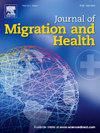宾夕法尼亚州移徙工人获得医疗服务的机会
IF 2.9
Q1 PUBLIC, ENVIRONMENTAL & OCCUPATIONAL HEALTH
引用次数: 0
摘要
H-2A临时农业工人计划每年将成千上万的外国工人带入美国,在农业部门工作。有充分证据表明,H-2A工人容易受到不安全工作条件和其他工作场所虐待的影响。受雇于农业部门的H-2A工人面临更高的工作场所危害率和更危险的工作场所环境,包括人口贩运的风险。作为生活在他们受雇的同一农场的外国出生工人,他们在获取雇主提供的资源之外的资源时面临语言和信息障碍。所有这些因素都对H-2A工人获得医疗保健造成了重大障碍。本文利用ArcGIS软件和公开信息分析了宾夕法尼亚州H-2A工作者医疗资源的接近性和可及性。我们发现,2021年,宾夕法尼亚州不到一半的H-2A工人居住在最适合满足其特殊需求的医疗保健提供者类型的15分钟车程内。我们还假定,这种方法今后可用于更好地分配资源和确定资源的优先次序,以创建干预点,并解决这一高危工人群体的独特需求,包括对贩运人口受害者的保健干预。本文章由计算机程序翻译,如有差异,请以英文原文为准。
Migrant workers’ access to medical service providers in Pennsylvania
The H-2A Temporary Agricultural Workers program brings hundreds of thousands of foreign workers into the United States to work in the agricultural sector each year. It is well documented that H-2A workers are susceptible and subjected to unsafe working conditions and other workplace abuses. Employed in the agricultural sector, H-2A workers are exposed to higher rates of workplace hazards and riskier workplace settings, including risk for human trafficking. As foreign-born workers living on the same farms in which they are employed, they face language and information barriers when accessing resources outside of those provided by their employer. All these factors contribute to creating significant barriers for H-2A workers when accessing healthcare. This paper uses ArcGIS software and publicly available information to analyze the proximity and accessibility of healthcare resources to H-2A workers in Pennsylvania. We find that less than half of H-2A workers in Pennsylvania in 2021 resided within a 15-minute drive of the types of healthcare providers best suited to address their particular needs. We also posit that this methodology could be used in the future to better allocate and prioritize resources to create intervention points and address the unique needs of this at-risk worker population, including health care interventions for human trafficking victims.
求助全文
通过发布文献求助,成功后即可免费获取论文全文。
去求助
来源期刊

Journal of Migration and Health
Social Sciences-Sociology and Political Science
CiteScore
5.70
自引率
8.70%
发文量
65
审稿时长
153 days
 求助内容:
求助内容: 应助结果提醒方式:
应助结果提醒方式:


